



Changes are coming. The UNC system is planning to increase enrollments during the next decade. 6,000 new students are proposed for the Chapel Hill campus: 4,000 undergraduate and 2,000 graduate students. These increases will bring the need for new buildings, additional faculty, and other infrastructure changes and improvements.
After many years of plans and proposals, an undergraduate major in computer science is closer to a reality than ever before. Our proposal for the new major will be presented to the General Administration office in January.
The Department will conduct its external review in February. I'd like to thank all of the alumni who returned the survey forms with comments about the Department. Alumni feedback is an important component of the review process, and I sincerely appreciate your taking the time to respond.
Read on for more of our recent and upcoming activities. We wish you a very happy 1999. As always, stop by and visit us if you are in the area.
Stephen F. Weiss

Teleclassroom upgrade
underway
In our fall issue we reported that the Frances C. and William P.
Smallwood Foundation had awarded our Department a $50,000
grant to upgrade the equipment in the Hugh Holman
Teleclassroom (room 011). The first phase of the upgrade has been
completed. David Musick, network coordinator, and
David Harrison, electronics technician for graphics,
installed new cameras and projection equipment. The new cameras
have greatly improved the clarity of our video broadcasts on the
NC-REN network, as well as the quality of our internal video
signals. Later phases will make the equipment more user friendly
and will provide further improvements in video quality. The next
phase will add an AMX multimedia control system, allowing the
user to control lighting, screens, and projectors from a single
console.
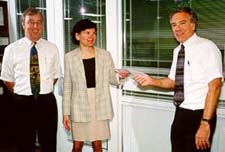
| Sally Muller, Smallwood Foundation trustee, presents the $50,000 grant to Stephen F. Weiss, professor and chairman (right) and Timothy L. Quigg, associate chair for administration and finance. (Photo: Todd Gaul) |
| Distinguished lecturer Randy Pausch, associate professor at Carnegie Mellon, gives the first talk to be broadcast with the new equipment in Sitterson 011. (video still) | 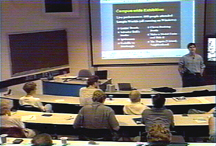
|

Aron Helser (M.S. 1998), research engineer on the nanoManipulator project, joined us full time in January. He had been a temporary employee on the project since receiving his master's from us last May.
Donna Knighten, accounting assistant, joined our administrative staff in November. She provides support to the accounting staff and assists in the personnel area. She previously worked for UNC's Department of Rheumatology and the Office of Contracts and Grants.
Warren Robinett, research scientist, rejoined us in December. He is working with the nanoManipulator project team, and is also working on some of the underlying software used by all our virtual environments projects. This spring he is teaching COMP 239: "Exploring Virtual Worlds." Warren worked here from 1989 to 1992 as the manager of the virtual reality lab.
Laura Schutz, systems administrator, joined us in November. She provides user support in the Technical Support Center; provides systems support on Macs; and runs backups of UNIX and Mac systems. She received a B.S. in mathematics with a physics minor from UNC in 1992 and previously worked for the University's Academic Technology and Networks office.
Sandeep Sen, a visiting research associate professor, is on sabbatical with us from September 1998 through July 1999. He is an associate professor of computer science and engineering at IIT, Delhi, India. His area of expertise is algorithms, and he works with Siddhartha Chatterjee, assistant professor, on the TUNE project.
Robert Palmer, electronics technician for the Microelectronic Systems Laboratory, who left in January to work at Chip2Chip Inc. in Milpitas, Calif. He had been with us since August 1998.
Ph.D.
*On to Ph.D. at UNC-Chapel Hill

Congratulations to . . .
20 years: Henry Fuchs, Janet Jones
5 years: James Anderson, Prasun Dewan, Nick England,
Bil Hays, William Jiang, and Stephen Tell (M.S. 1991)
M.S.
Amaury Alvarez, Herman Harjono, Kwang-Soo Kim, Adam
Lake, Renee Maheshwari, Yufei Qian, Ellen Scher Zagier*, and
Anshu Sharma
Effective 1 January 1999:
John G. Eyles, research associate professor
Prasun Dewan, professor
David Stotts, associate professor, associate chair for
academic affairs
Research highlights
Researchers will study existing collaborations between the Department of Chemistry at UNC and NIEHS, as well as collaborations between UNC's Gene Therapy Center and the Department of Physics and Astronomy. Currently, investigators have been walking or driving between sites to collaborate. The project provides them with shared applications, televideo, and remote control of the nanoManipulator, allowing them to work together without leaving their laboratories.
New investigators on the project are Kevin Jeffay, associate professor, and Don Smith (Ph.D. 1978), research professor, who are studying the network issues; Eileen Kupstas-Soo (M.S. 1992), graduate student, and Diane Sonnenwald, assistant professor in the School of Information and Library Science, who are studying the effectiveness of the collaboration; and Dorothy Erie, assistant professor in the Department of Chemistry, and Jude Samulski, associate professor of pharmacology and director of the Gene Therapy Center, who are using the remote nanoManipulator system to collaborate over the network. For more information, see www.cs.unc.edu/Research/nano/.
In his nominating letter, Stephen F. Weiss, professor and chairman, wrote, "Dinesh is a superb researcher who has already accomplished much in a very short time and shows no signs of slowing down." Since joining us in 1992, Dinesh has pursued research in computer graphics and computational geometry. He has won grants worth more than $4 million and has produced a number of journal articles, book chapters, software products, and videos. Robotics simulation systems vendors are using his algorithm, and his work on topics such as collision detection has been applied in Department of Defense laboratories.
During the same week, Henry, Guido, and Steve attended the Conference on Medical Image Computing and Computer-Aided Interventions in Cambridge, Mass., where Steve presented a tutorial on object shape with two colleagues from the University of Manchester.
On 22 October the Department hosted an open-house reception and demos for conference participants, giving us the opportunity to show our graphics and imaging research to the international visualization community. More than 200 conference attendees visited Sitterson Hall for demos of a number of projects, including collision detection, depth extraction, haptic feedback, image-based rendering, medical imaging, molecular dynamics, morphing, nanoVIZ, nanoWorkbench, the Office of the Future, protein interactive theater, the power plant walkthrough, ultrasound, and the new walking experience.
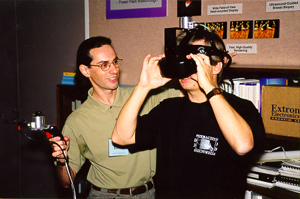 | Visualization '98 Open House: Jarek Rossignac, professor in the College of Computing and director of the Graphics, Visualization and Usability Center at Georgia Tech, tries out the Walking Experience, with the assistance of Rui Bastos, graduate student. (Photo: Todd Gaul) |

Frederick P. Brooks, Jr., Kenan professor, et al. "Interactive Graphics for Molecular Studies and Microscopy--Supplement for Collaboratory," National Institutes of Health.
Henry Fuchs, Federico Gil professor, et al. "MRI: Acquisition of a Graphics Supercomputer for Synthetic Environments Serving Science and Engineering," National Science Foundation (NSF).
Henry Fuchs. "MRI Equipment Grant for Science and Technology Center for Computer Graphics and Scientific Visualization," NSF, University of Utah.
Ming C. Lin. "Efficient Geometric Algorithms for Computer Simulated Environments," NSF.

Recent publications
Anderson, J., R. Jain, and K. Jeffay. "Efficient Object Sharing in
Quantum-Based Real-Time Systems," Proc. 19th IEEE Real-Time
Systems Symposium, 2-4 December 1998, 346-355.
Anderson, J., R. Jain, and D. Ott. "Wait-Free Synchronization in Quantum-Based Multiprogrammed Systems," Proc. 12th International Symposium on Distributed Computing, September 1998, 34-48.
Arthur, K., T. Preston, R. M. Taylor II, F. P. Brooks Jr., M. C. Whitton, and W. V. Wright. "Designing and Building the PIT: a Head-Tracked Stereo Workspace for Two Users," Proc. Second International Immersive Projection Technology Workshop, 11-12 May 1998. UNC Department of Computer Science Technical Report TR98-015.
Falvo, M. R., G. Clary, A. Helser, S. Paulson, R. M. Taylor II, V. Chi, F. P. Brooks Jr., S. Washburn, and R. Superfine. "Nanomanipulation Experiments Exploring Frictional and Mechanical Properties of Carbon Nanotubes," Microscopy and Microanalysis, 4(5), 1998.
Goddard, S., and K. Jeffay. "Managing Memory Requirements in the Synthesis of Real-Time Systems from Processing Graphs," Proc. Fourth IEEE Real-Time Technology and Applications Symposium, June 1998, 59-70.
Gopi, M., and D. Manocha. "A Unified Approach for Simplifying Polygonal and Spline Models," Proc. IEEE Visualization '98, 18-23 October 1998, 271-278, 543.
Jeffay, K., F. D. Smith, A. Moorthy, and J. Anderson. "Proportional Share Scheduling of Operating System Services for Real-Time Applications," Proc. 19th IEEE Real-Time Systems Symposium, 2-4 December 1998, 480-491.
Paramasivam, M., and D. A. Plaisted. "Automated Deduction Techniques for Classification in Description Logic Systems," Journal of Automated Reasoning, 20(3), June 1998, 337-364.
Parris, M., K. Jeffay, F. D. Smith, and J. Borgersen. "A Better-Than-Best-Effort Service for Continuous Media UDP Flows," Proc. Eighth International Workshop on Network and Operating System Support for Digital Audio and Video, July 1998, 193-197.
Popescu, V. S., A. Lastra, D. G. Aliaga, and M. de Oliveira Neto. "Efficient Warping for Architectural Walkthroughs Using Layered Depth Images," Proc. IEEE Visualization '98, 18-23 October 1998, 211-215, 535.
Taylor II, R. M. "Network Access to a PHANToM Through VRPN," Proc. PHANToM User's Group Workshop, 3-6 October 1998.

In the media
A variety of articles about our news and research, including
augmented reality, nanoManipulator work with carbon nanotubes,
and other subjects appeared during 1998 in the News and Observer
of Raleigh and in two UNC publications, the Carolina Alumni
Review and Endeavors.
Our virtual reality research appears in a book in the Facts on File Science Sourcebooks series: Grady, Sean M. Virtual Reality: Computers Mimic the Physical World, New York: Facts on File, 1998, chapters 3, 5, 6, and 7.
A photograph of former graduate student Mark Mine (Ph.D. 1997) "flying through molecules" appears in a fifth-grade social studies textbook, part of the "Living in Our World" series: The Americas, Raleigh, NC: North Carolina State University Humanities Extension/Publications Program, 1998, 305.
A description of our augmented reality work and quotes by Henry Fuchs, Federico Gil professor, appear in Charlene Marietti's article, "Advanced Medical Techniques and Technologies are on their Way to a Facility Near You," in Healthcare Informatics, January 1998, 38-46.
A brief article about our nanotube research, "Nanotubes sous Contrainte," appeared in Science et Vie, No. 964, January 1998, 14.
The students were also able to observe James's struggle to get his
ARCTIC distributed programming environment into usable shape
before the final student's presentation, which relied on ARCTIC.
Several lectures concerned design issues that arose during the final
push to make ARCTIC work. ARCTIC ran its first fully distributed
application two days before the final presentation. For information
on ARCTIC, visit
www.cs.unc.edu/Research/ARCTIC/. James expects to
announce its release for general use in the near future.
During the course, students studied classic problems and
developed solutions using advanced object-oriented programming
techniques. Problems included the k-Queens Problem, the Knight's
Tour, the Perfect Shuffle Problem, Deferred-Response 20 Questions,
TopSpin, the 15-Puzzle, the L-Game, Sequence Comparison, the
Sieve of Eratosthenes, the Monte Hall Problem, and some
distributed implementations of simple problems such as Readback
and WAR. For problem definitions, see
www.cs.unc.edu/~coggins/Teaching/Classics.
The I2-DSI initiative will develop and refine advanced server
system technology located throughout the network to store and
deliver efficiently terabytes of data to users at any Internet2
campus. It is led by Micah Beck and Terry
Moore of the University of Tennessee and Bert
Dempsey, assistant professor in the School of Information and
Library Science and adjunct assistant professor of computer science
at UNC.
Internet2 is being designed to provide research and educational
institutions with next-generation inter-networking and to better
serve traffic requirements by creating a high-capacity point of
presence (GigaPOP). Our Department's Multimedia Networking
Lab is the network's point of presence at UNC. For more
information, see
www.internet2.edu and
http://dsi.internet2.edu.

Other news
Advanced Programming Class introduced to ARCTIC
Students in the fall 1998 Advanced Computer Programming course
(COMP 190-031), taught by James Coggins, associate
professor, learned much more than advanced computer
programming. They also gained experience in making formal
presentations of their solutions to classic programming problems.
These presentations were held in Sitterson 011 and used the
computer display facilities to present PowerPoint slides and demos
of their programs in action. New Internet2 Initiative
In September, the Internet2 project announced the Internet2
Middleware Initiative to accelerate the development of advanced
network applications. As part of this new initiative, IBM Corp. will
provide its state-of-the-art high-speed storage devices to the
Internet2 Distributed Storage Infrastructure initiative (I2-DSI).
Additional support for the I2-DSI will be provided by StorageTek, a
new Internet2 corporate sponsor, as well as Cisco Systems, Sun,
and Novell. For the initial I2-DSI testbed, IBM servers with
approximately 1 terabyte of storage and 1 gigabyte of RAM are
being installed at high-speed backbone access points in North
Carolina, Hawaii, Indiana, South Dakota, and Tennessee.
Collaborations with Canadian, European, and Japanese networks
are under discussion. IBM will also contribute a host of advanced
supercomputer and video technologies to the International Center
for Advanced Internet Research (iCAIR) for the Internet2 Digital
Video Network Initiative (I2-IDV), which will develop and deploy
advanced network technology to establish a national higher
education video network service. Coggins Retires as Associate Chair
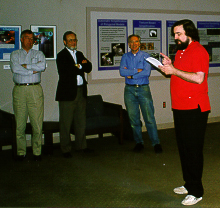 | At a party in his honor, James Coggins, associate professor, reads his "Top 10" list of things he learned during his six years as the Department's associate chair for academic affairs. For the list, see www.cs.unc.edu/~coggins/Service/AssocChair/TopTenList.html. David Stotts, associate professor, took over James's role as associate chair in January. |
| James leaves for a sabbatical in Manchester, England, in February, along with his wife Leslie and his daughter Caitlin (right). He will work at the Wolfson Image Analysis Unit of the Department of Medical Biophysics at the University of Manchester. (Photos: Jai Glasgow) | 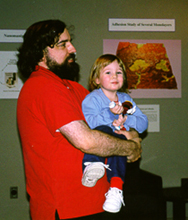
|

Stephen Brumback and Melissa Dewey married on 17 October 1998 in Elmira, N.Y.
Seth David Gooding was born on 30 August 1998 in Raleigh, N.C., to David Gooding and Shannon Stephenson Gooding (B.S. MSci. 1992).
Breanne Rachel Hewitt was born on 5 January 1998 in Raleigh, N.C., to W. Joe Hewitt (B.S. MSci. 1988) and Susan King Hewitt (B.S. MSci. 1987).
Elizabeth Lakey Holloway was born on 9 September 1998 in Durham, N.C., to Richard Holloway (Ph.D. 1995) and Barbara Holloway. She has two older sisters, Alexa and Bergen.
Helen Wenyi Jiang was born on 2 January 1999 in Chapel Hill, N.C., to William Jiang and Anna Kung.
Selina Kyle McDaniel was born on 11 October 1998 in Chapel Hill, N.C., to Jason and Candice McDaniel.
Stuart Whitaker Petty was born on 14 July 1998 in Chapel Hill, N.C., to Chad and Joy Petty.
Anameeka Singh was born on 19 December 1998 in Cary, N.C., to Raj and Ranjana Singh. She has an older brother, Ashutosh, who is five.
Cassandra Lauren Turk was born on 1 October 1998 in Atlanta, Ga., to Greg Turk (Ph.D. 1992) and Mary McFarlane.
Chelsea Lan Yu was born on 16 October 1997 in Orlando, Fla., to Liyun Yu and Ruihua Zhang. She has an older sister, Lily, who is eighteen.
Ron Azuma (Ph.D. 1995) presented a recent paper, co-written with, among others, some UNC alumni and current UNC faculty: Azuma, R. T., B. R. Hoff, H. E. Neely III, R. Sarfaty, M. J. Daily, G. Bishop, V. Chi, G. Welch, U. Neumann, S. You, R. Nichols, and J. Cannon. "Making Augmented Reality Work Outdoors Requires Hybrid Tracking," Proc. First International Workshop on Augmented Reality, 1 November 1998. (azuma@HRL.com)
Edoardo S. Biagioni (Ph.D. 1992), assistant professor at the University of Hawaii at Manoa, now lives on a 47-foot sailboat. See www.ics.hawaii.edu/~esb/pers.html for pictures. (esb@hawaii.edu)
Randy Brown (M.S. 1990) has joined SouthPeak Interactive as a senior systems developer. He is co-developing a car-driving simulator application using the company's Video Reality(TM) technology. (randy@southpeak.com)
Jonathan D. Cohen (Ph.D. 1998) is an assistant professor at Johns Hopkins University. He taught "Rendering Techniques" in the fall semester and is teaching "Visual Computing" this spring. (cohen@cs.jhu.edu)
L. Annette Foster (M.S. 1975) is the Year 2000 Compliance Officer for Duke University and is wondering why we didn't start using four-digit years sooner than now! (annette.foster@duke.edu)
Geoffrey A. Frank (Ph.D. 1979) is principal scientist at the Center for Digital Systems Engineering at the Research Triangle Institute. He recently co-edited the book, Rapid Prototyping of Application Specific Signal Processors (Kluwer), and co-wrote one of its chapters. His paper, "Tools for Rapid Construction of VHDL Performance Models for DSP Systems," co written with F. Gail Gray and his students at Virginia Tech., won the Best Paper Award at the 1998 International Verilog HDL Conference and VHDL International Users Forum. (gaf@rti.org)
Gopal Gupta (Ph.D. 1992) has been named to the editorial board of the Journal of Logic Programming. He is organizing the First International Workshop on Practical Aspects of Declarative Languages to be held with the ACM Principles of Programming Languages Conference in San Antonio, Texas. Gopal is also the general chair of the 16th International Conference on Logic Programming to be held in Las Cruces, N.M. He invites those who are interested to attend both events. See www.cs.nmsu.edu/~gupta for details. (gupta@cs.nmsu.edu) Some of his recent papers are:
Gupta, G., E. Pontelli, A. Lara, and R. Cardenas. "Automatic Derivation of a Parallelizing Compiler," Proc. International Conference on Parallel Processing, August 1998, 579-586.Lenwood S. Heath (Ph.D. 1985) has several recent journal publications:Karshmer, A., G. Gupta, S. Geiger, and C. Weaver. "A Framework for Translation of Braille Nemeth Math to LaTeX," Proc. ACM Conference on Assistive Technologies, April 1998, 136-143.
Pontelli, E., and G. Gupta. "Efficient Parallel Implementation of Backtracking," Proc. International Conference on Parallel Processing, August 1998, 338-345.
Pontelli, E., G. Gupta, J. Wiebe, and D. Farwell. "Natural Language Multiprocessing: A Case Study," AAAI National Conference on Artificial Intelligence, MIT Press, July 1998, 78-84.
Ganley, J. L., and L. S. Heath. "An Experimental Evaluation of Local Search Heuristics for Graph Partitioning," Computing, Vol. 60, 1998, 121-132.Lenny, an associate professor at Virginia Tech. in Blacksburg, Va., is co-principal investigator on a three-year National Science Foundation grant, "A System for Symbolic Computation in Hopf Algebras." (heath@cs.vt.edu)Heath, L. S., and J.P.C. Vergara. "Edge-Packing in Planar Graphs," Theory of Computing Systems, Vol. 31, 1998, 629-662.
Heath, L. S., and J.P.C. Vergara. "Edge-Packing Planar Graphs by Cyclic Graphs," Discrete Applied Mathematics, Vol. 81, 1998, 169-180.
Ellen Johnson (M. S. 1981) retired in January from the Department of Molecular and Cell Physiology at UNC, where she was an analyst programmer. During her 17 years in the department she developed software for the acquisition and display of neuroanatomical and electrophysiological data, and published articles on the use of computers in neurobiological research. (emjo@med.unc.edu)
Peter Litwinowicz (M.S. 1987) co-developed the Motion Paint(SM) system that was used for 8 1/2 minutes of special effects in the film "What Dreams May Come." He worked on the "Painted World" sequence where Robin Williams's character wakes up in a world of wet, and not-so-wet, paint. He is co-founding a company, RE:Vision Effects, Inc., to develop software products for the moving image authoring industry using image processing, computer vision, non-photorealistic rendering, and image-based modeling, rendering, and animation. (litwinow@best.com)
Mark Livingston (Ph.D. 1998) defended his dissertation in October and joined Hewlett-Packard Laboratories in Palo Alto, Calif. (livingst@cs.unc.edu)
Tom Palmer (M.S. 1987) has joined Interpath Communications, Inc., in Research Triangle Park, N.C., where he consults, and also manages Web development projects. (tom.palmer@interpath.net)
Chris Schleter (M.S. 1981) is a manager of Sport Services for the Sydney 2000 Olympic Games. His group is responsible for the interface between sport and technology, including result systems, entry systems, and communications. (sprtstat@ix.netcom.com)
Yen-Ping Shan (Ph.D. 1990) recently left IBM Corp. in Research Triangle Park, N.C., to join Automatic Data Processing in Roseland, N.J., as vice president of Client Server Development/Network Computing. (yen-ping_shan@es.adp.com)
Nancy Stegman (M.S. 1976) recently completed her first year as chief information officer and chief of the Computer Technology Branch at the National Institute of Environmental Health Sciences in Research Triangle Park, N.C. (stegman@niehs.nih.gov)
Philip R. Fittante (B.S. MSci. 1987), a test pilot in the U. S. Air Force, is currently stationed at Edwards Air Force Base, Calif., where he performs test flights in the B-1 and B-2. He was recently promoted to major. Philip is married with two children. (pfittante@prodigy.net)
Chris Helvig (B.S. MSci. 1995) received his M.S. in computer science from the University of Virginia in May 1998. He attended conferences in France, Italy, and California and wrote a number of publications (see www.cs.virginia.edu/~csh5t). He now develops computer games at Volition, Inc. (chris@volition-inc.com)
W. Joe Hewitt (B.S. MSci. 1988) recently joined Premier Systems Integrators as their professional services manager. He and his wife Susan King Hewitt (B.S. MSci. 1987) live in Raleigh, N.C., with their daughter Breanne (see "Family Matters"). (joe.hewitt@premier-systems.net, shewitt@interpath.com)
Mark Hutchinson (B.S. MSci. 1981) is a self-employed contract software instructor and consultant. He is the founder and contact person for the RTP-Delphi Interest Group. (Aikimark@aol.com)
Christopher Brant Hyatt (B.S. MSci. 1993) and Stephanie Lanza Hyatt (B.S. MSci. 1992) are both in graduate school. He is working on his MBA at Carnegie Mellon University. (chyatt@andrew.cmu.edu). Stephanie received her M.S. in May 1998 in human development methodology from Pennsylvania State University and is working on her Ph.D. Her research is in continuous and categorical latent variable models for analyzing longitudinal data. (slh@bony.hhdev.psu.edu).
Gib Johnson (B.S. MSci. 1987) is vice president in charge of all Florida operations for Broadreach Consulting, Inc. (www.BroadreachConsulting.com), a technology consulting company focused on eBusiness Internet Solutions. The company's primary services are management consulting, application solutions, and technology infrastructure. (Gib.Johnson@BroadreachConsulting.com)
Karen Roberts Meyer (B.S. MSci. 1987) was recently promoted to second vice president at General Reinsurance Corporation in Chicago, Ill. (kmeyer@genre.com)
Richard A Peller (B.S. MSci. 1990) has been promoted to director of development at BridgePoint Incorporated, a CSX Corporation business unit based in Cary, N.C. (Ric_Peller@Bridge-Point.com)
David K. Schandler (B.S. MSci. 1988) is operations manager for the Integrated Naval Research Information System project for the Office of Naval Research. He reports needing more developers. Send your resume if you know Oracle and would like to work in the D.C. area. David was recently elected to a second term on the Board of Directors of the Arlington, Va., chapter of the American Red Cross, and was a recipient of the 1998 American Red Cross Chairmen's Award for Inspiration. (www.bigfoot.com/~firewalker) (firewalker@bigfoot.com)
Co-editors:
Jeannie M. Walsh,
walsh@cs.unc.edu
Claire L. Stone,
stonec@cs.unc.edu
Keep in touch!
Let us know where you are and what you are
doing so that we can include you in our next issue! Send us
information via e-mail to pubs@cs.unc.edu; fax it to
919-962-1799; or mail it to the address below, c/o News &
Notes.
Please include your e-mail address.
Department of Computer Science
UNC-Chapel Hill
CB#3175, Sitterson Hall
Chapel Hill, NC 27599-3175
General information:
Voice: 919/962-1700
Fax: 919/962-1799
Internet mail: info@cs.unc.edu
World Wide Web: www.cs.unc.edu
Address corrections, submissions, and for information about our publications: pubs@cs.unc.edu
UNC is an Equal Opportunity/Affirmative Action Institution.


